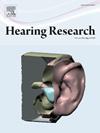Middle-aged CBA/CaJ mice exhibit auditory dysfunction in background noise
IF 2.5
2区 医学
Q1 AUDIOLOGY & SPEECH-LANGUAGE PATHOLOGY
引用次数: 0
Abstract
Aging is associated with deficits in auditory functioning. Characterization of auditory deficits that originate in middle-age is crucial for understanding the initial age-related functional impairments and the spatio-temporal progression of age-related auditory pathophysiology. Early age-related deficits in auditory processing are evident in difficult listening conditions, such as background noise, before becoming evident in quiet. To investigate the effect of noise on age-related auditory dysfunction, we collected suprathreshold auditory brainstem responses (ABRs) from young, middle-aged, and aged CBA/CaJ mice in quiet and broad-band background noise. We utilized multiple ABR metrics, including phase locking value (PLV), a measure of neural synchrony correlated to speech-in-noise understanding in humans. Despite no differences in auditory processing in quiet between young and middle-aged mice, middle-aged mice exhibited a distinct auditory phenotype from both young and aged mice in background noise conditions. We found that noise significantly decreased amplitude in middle-aged mice more than in young and aged mice. Noise significantly increased latencies for wave I and V in young mice, but only affected wave V in middle-aged mice and did not affect aged latencies. Noise significantly decreased PLV in middle-aged mice to a greater extent than in young mice, but to a lesser extent in aged mice. These results show that middle-aged mice have a distinct, auditory dysfunction phenotype evident in background noise. Our data show that suprathreshold auditory function in noise can identify early age-related hearing loss and can be used as a sensitive tool for detecting auditory dysfunction in normal hearing animal models.

中年CBA/CaJ小鼠在背景噪声中表现出听觉功能障碍
衰老与听觉功能的缺陷有关。对中年人的听觉缺陷进行表征,对于理解与年龄相关的初始功能障碍和与年龄相关的听觉病理生理的时空进展至关重要。与早期年龄相关的听觉处理缺陷在困难的听力条件下很明显,比如背景噪音,然后在安静的环境中变得明显。为了研究噪声对年龄相关性听觉功能障碍的影响,我们收集了年轻、中年和老年CBA/CaJ小鼠在安静和宽带背景噪声下的阈上听脑干反应(ABRs)。我们使用了多个ABR指标,包括锁相值(PLV),这是一种与人类在噪音中理解语音相关的神经同步性指标。尽管年轻和中年小鼠在安静条件下的听觉处理没有差异,但背景噪声条件下,中年小鼠表现出与年轻和老年小鼠不同的听觉表型。我们发现噪音在中年小鼠中显著降低幅度比在年轻和老年小鼠中更明显。噪声显著增加了年轻小鼠的波I和波V潜伏期,但只影响中年小鼠的波V潜伏期,而不影响老年小鼠的波V潜伏期。噪声显著降低中年小鼠的PLV程度大于年轻小鼠,但对老年小鼠的影响较小。这些结果表明,中年小鼠在背景噪声中具有明显的听觉功能障碍表型。我们的数据表明,噪声中的阈上听觉功能可以识别早期相关性听力损失,并可作为检测正常听力动物模型听觉功能障碍的敏感工具。
本文章由计算机程序翻译,如有差异,请以英文原文为准。
求助全文
约1分钟内获得全文
求助全文
来源期刊

Hearing Research
医学-耳鼻喉科学
CiteScore
5.30
自引率
14.30%
发文量
163
审稿时长
75 days
期刊介绍:
The aim of the journal is to provide a forum for papers concerned with basic peripheral and central auditory mechanisms. Emphasis is on experimental and clinical studies, but theoretical and methodological papers will also be considered. The journal publishes original research papers, review and mini- review articles, rapid communications, method/protocol and perspective articles.
Papers submitted should deal with auditory anatomy, physiology, psychophysics, imaging, modeling and behavioural studies in animals and humans, as well as hearing aids and cochlear implants. Papers dealing with the vestibular system are also considered for publication. Papers on comparative aspects of hearing and on effects of drugs and environmental contaminants on hearing function will also be considered. Clinical papers will be accepted when they contribute to the understanding of normal and pathological hearing functions.
 求助内容:
求助内容: 应助结果提醒方式:
应助结果提醒方式:


